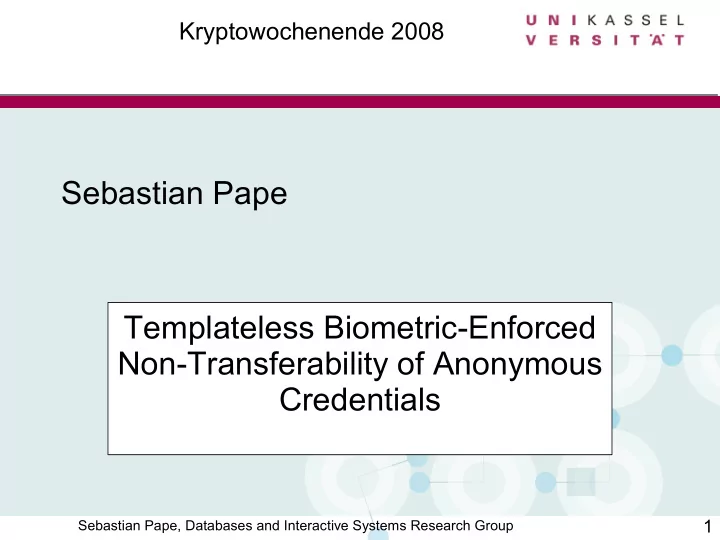

Kryptowochenende 2008 Sebastian Pape Templateless Biometric-Enforced Non-Transferability of Anonymous Credentials 1 Sebastian Pape, Databases and Interactive Systems Research Group
Overview ● Motivation ● Anonymous Credentials ● Problems with Biometrics ● Wallet-with-Observer Architecture ● Existing Approaches ● Idea ● Example ● Outlook 2 Sebastian Pape, Databases and Interactive Systems Research Group
Motivation ● Cryptographic primitives are based on secrets ● Private keys for digital signatures ● Secrets in Zero-Knowledge-Proofs (ZKP) ● Secret is knowledge and knowledge can be ● Stolen ● Transfered to someone ● How can you be sure the secret was used by its regular owner? 3 Sebastian Pape, Databases and Interactive Systems Research Group
Anonymous Credentials ● Consist of cryptographic tokens ● Allow authentication without identification ● Based on ZKP ● Non-transferablity may be wished ⇒ Make the user not wanting to share ⇒ Embed valuable secrets into the system ⇒ Share nothing-or-all strategy ✗ Can be circumvented ✗ Raise system's value ⇒ Keep tokens secret from user ● Use of Biometrics 4 Sebastian Pape, Databases and Interactive Systems Research Group
Problems with Biometrics ● Finding good/usable attributes ● Fingerprints ● Universality ● Circumvention ● Cannot be changed ● False nonmatch rate vs. False match rate ● Privacy Issues 5 Sebastian Pape, Databases and Interactive Systems Research Group
Hardware (outdated) Source: www.fidelica.com ● Privacy problem: Template database 6 Sebastian Pape, Databases and Interactive Systems Research Group
Hardware (match-on-card) Source: www.fidelica.com ● No template database ● Privacy problem: Eavesdropper 7 Sebastian Pape, Databases and Interactive Systems Research Group
Hardware (embedded) Source: www.fidelica.com ● No template database ● Protected against eavesdropper 8 Sebastian Pape, Databases and Interactive Systems Research Group
Some Problems of Biometrics ● Finding good/usable attributes ● Fingerprints ● Universality ● Circumvention ● Cannot be changed ● False nonmatch rate vs. False match rate ● Privacy Issues ● Trust to system 9 Sebastian Pape, Databases and Interactive Systems Research Group
Wallet-with-Observer Architecture Wallet Observer Verifier ● General Problem: Contact to "correct card"? 10 Sebastian Pape, Databases and Interactive Systems Research Group
Wallet-with-Observer Architecture + Biometrics Wallet Observer Verifier ● Biometrics to Observer 11 Sebastian Pape, Databases and Interactive Systems Research Group
Existing Approaches ● Current approaches compare biometrics to templates ✔ Underlying system needs no change ✗ Stored Templates ● Fuzzy extractors provide same output to "close" input ● "error correcting hash" ● Private keys can be derived from Biometrics fe( ) s ✗ Derived keys need to suit to underlying system ✔ No templates/storage needed 12 Sebastian Pape, Databases and Interactive Systems Research Group
Idea ● Combine Advantages ⇒ No Templates stored ⇒ No change of underlying system fe( ) XOR, mod, ... s * s 13 Sebastian Pape, Databases and Interactive Systems Research Group
Example (Setup) based on Feige-Fiat-Shamir Id.-Protocol Authority chooses two large prime integers p,q calculates n= p * q generates s 1 , ... , s k with gcd(s i ,n) = 1 computes v i ≡ s i 2 (mod n) Public (known by verifier and prover): n, v i Secret (kept inside the smartcard): s i Secret (kept by authority): p, q Card initialization: s i is overwritten by s * i ≡ s i - fe(fp u ) (mod n) 14 Sebastian Pape, Databases and Interactive Systems Research Group
Example (Prove) based on Feige-Fiat-Shamir Id.-Protocol Smartcard: chooses a random integer r, a random sign {-1,1} computes x ≡ r 2 (mod n) V Verifier: chooses numbers a i {0,1} S s Smartcard: reads fingerprint fp u computes y ≡ r(s * 1 +fe(fp u )) a 1 * ... * (s * k +fe(fp u )) a k (mod n) V Verifier: 2 ≡ x v 1 checks if y a 1 * ... * v k a k (mod n) decides if the prover has passed authorisation. 15 Sebastian Pape, Databases and Interactive Systems Research Group
Outlook Connection to proper smartcard? User interleaved Use of flexible display 2 e.g. for r Unlimited number of uses base on n-time anonym. authentification Concrete implementation Source: www.fidelica.com 16 Sebastian Pape, Databases and Interactive Systems Research Group
Recommend
More recommend